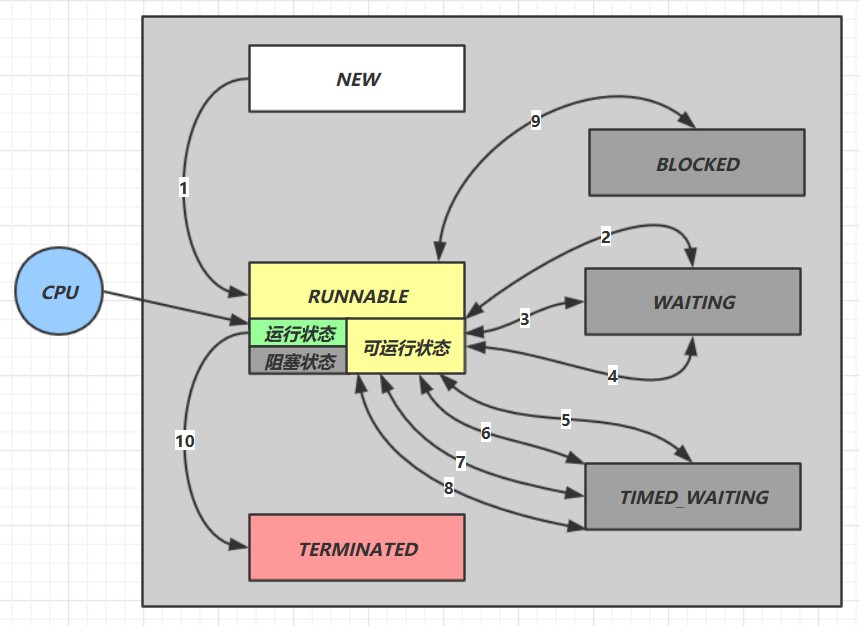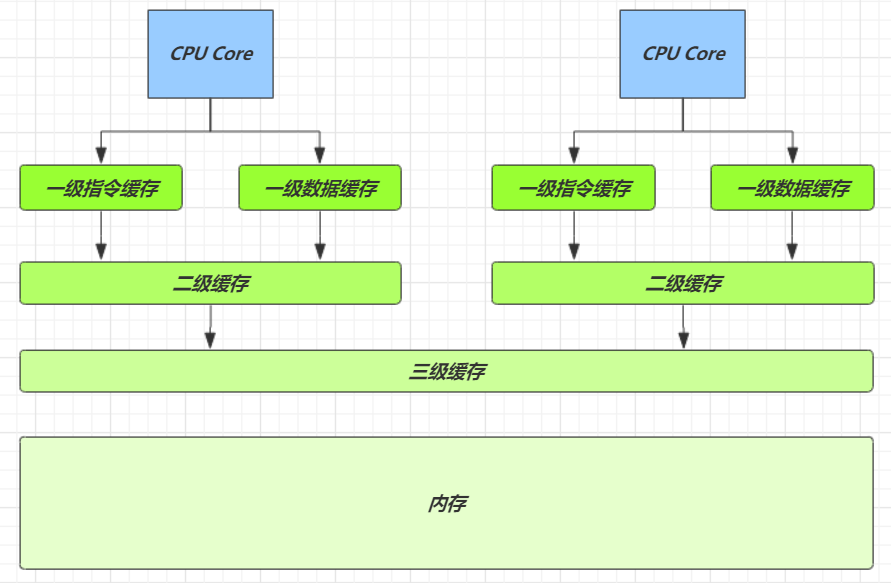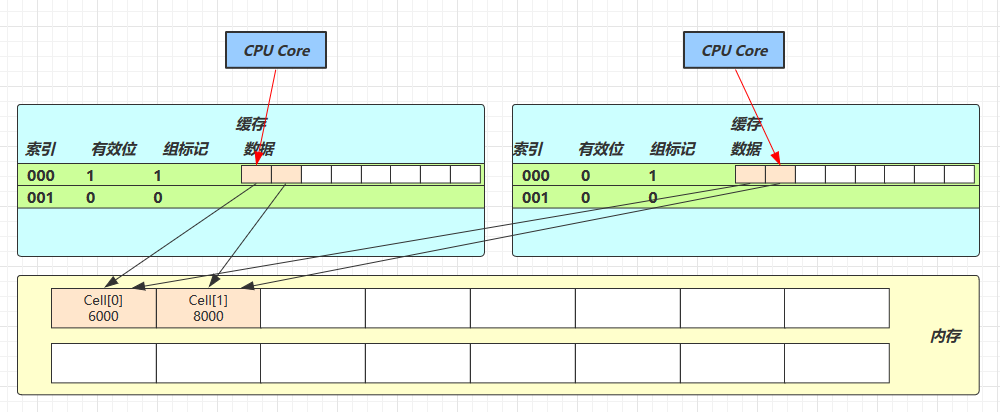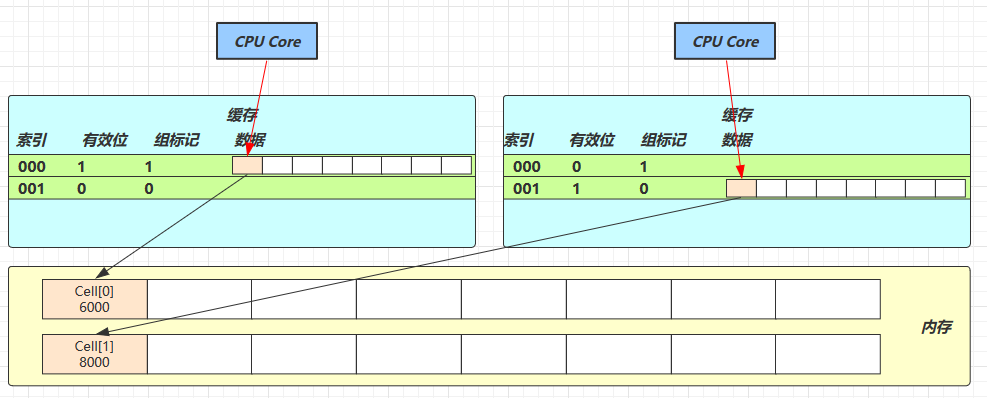本章内容
CAS 与 volatile
原子整数原子引用原子累加器Unsafe
问题提出
有如下需求,保证
account.withdraw
取款方法的线程安全


package cn.itcast;
import java.util.ArrayList; import java.util.List;
interface Account {
// 获取余额
Integer getBalance();
// 取 款
void withdraw(Integer amount);
/**
- 方法内会启动 1000 个线程,每个线程做 -10 元 的操作
- 如果初始余额为 10000 那么正确的结果应当是 0
*/
static void demo(Account account) { List
for (int i = 0; i < 1000; i++) { ts.add(new Thread(() -> {
account.withdraw(10);
}));
}
ts.forEach(Thread::start); ts.forEach(t -> {
try {
t.join();
} catch (InterruptedException e) { e.printStackTrace();
}
});
long end = System.nanoTime(); System.out.println(account.getBalance()
+ “ cost: “ + (end-start)/1000_000 + “ ms”);
}
}
原有实现并不是线程安全的
class AccountUnsafe implements Account { private Integer balance;
public AccountUnsafe(Integer balance) { this.balance = balance;
}


@Override
public Integer getBalance() { return balance;
}
@Override
public void withdraw(Integer amount) { balance -= amount;
}
}
执行测试代码
public static void main(String[] args) { Account.demo(new AccountUnsafe(10000));
}
某次的执行结果
330 cost: 306 ms
为什么不安全
方法
withdraw
public void withdraw(Integer amount) { balance -= amount;
}
对应的字节码
ALOAD 0
ALOAD 0
GETFIELD cn/itcast/AccountUnsafe.balance : Ljava/lang/Integer; INVOKEVIRTUAL java/lang/Integer.intValue ()I
ALOAD 1
INVOKEVIRTUAL java/lang/Integer.intValue ()I ISUB
INVOKESTATIC java/lang/Integer.valueOf (I)Ljava/lang/Integer;
PUTFIELD cn/itcast/AccountUnsafe.balance : Ljava/lang/Integer;
// <- this
// <- this.balance
// 拆 箱
// <- amount
// 拆 箱
// 减 法
// 结果装箱
// -> this.balance
多线程执行流程
ALOAD 0
ALOAD 0
GETFIELD cn/itcast/AccountUnsafe.balance INVOKEVIRTUAL java/lang/Integer.intValue ALOAD 1
INVOKEVIRTUAL java/lang/Integer.intValue
// thread-0 <- this
// thread-0 <- this.balance
// thread-0 拆 箱
// thread-0 <- amount
// thread-0 拆 箱


ISUB // thread-0 减 法
INVOKESTATIC java/lang/Integer.valueOf // thread-0 结果装箱
PUTFIELD cn/itcast/AccountUnsafe.balance // thread-0 -> this.balance
ALOAD 0
ALOAD 0
GETFIELD cn/itcast/AccountUnsafe.balance INVOKEVIRTUAL java/lang/Integer.intValue ALOAD 1
INVOKEVIRTUAL java/lang/Integer.intValue ISUB
INVOKESTATIC java/lang/Integer.valueOf
PUTFIELD cn/itcast/AccountUnsafe.balance
// thread-1 <- this
// thread-1 <- this.balance
// thread-1 拆 箱
// thread-1 <- amount
// thread-1 拆箱
// thread-1 减法
// thread-1 结果装箱
// thread-1 -> this.balance
解决思路-锁
首先想到的是给 Account 对象加锁
class AccountUnsafe implements Account { private Integer balance;
public AccountUnsafe(Integer balance) { this.balance = balance;
}
@Override
public synchronized Integer getBalance() { return balance;
}
@Override
public synchronized void withdraw(Integer amount) { balance -= amount;
}
}
结果为
0 cost: 399 ms
解决思路-无锁
class AccountSafe implements Account { private AtomicInteger balance;
public AccountSafe(Integer balance) { this.balance = new AtomicInteger(balance);


}
@Override
public Integer getBalance() { return balance.get();
}
@Override
public void withdraw(Integer amount) { while (true) {
int prev = balance.get(); int next = prev - amount;
if (balance.compareAndSet(prev, next)) { break;
}
}
// 可以简化为下面的方法
// balance.addAndGet(-1 * amount);
}
}
执行测试代码
public static void main(String[] args) { Account.demo(new AccountSafe(10000));
}
某次的执行结果
0 cost: 302 ms
CAS 与 volatile
前面看到的 的解决方法,内部并没有用锁来保护共享变量的线程安全。那么它是如何实现的呢?
AtomicInteger
public void withdraw(Integer amount) { while(true) {
// 需要不断尝试,直到成功为止
while (true) {
// 比如拿到了旧值 1000
int prev = balance.get();
// 在这个基础上 1000-10 = 990 int next = prev - amount;
/*
compareAndSet 正是做这个检查,在 set 前,先比较 prev 与当前值
- 不一致了,next 作废,返回 false 表示失败
比如,别的线程已经做了减法,当前值已经被减成了 990
那么本线程的这次 990 就作废了,进入 while 下次循环重试
- 一致,以 next 设置为新值,返回 true 表示成功
*/
其中的关键是 compareAndSet,它的简称就是 CAS (也有 Compare And Swap 的说法),它必须是原子操作。
线程1
Account 对 象
线程2
获取余额 100
减10
已经修改为 90 了
减10
减10
线程1
Account 对 象
线程2
cas(80, 70)
= 70
获取余额 80
cas(90, 80)
= 80
获取余额 90
已经修改为 80 了
cas(100, 90)
= 90
 注意
注意

if (balance.compareAndSet(prev, next)) {
break;
}
}
}
}
其实 CAS 的底层是换】的原子性。
lock cmpxchg
指令(X86 架构),在单核 CPU 和多核 CPU 下都能够保证【比较-交

在多核状态下,某个核执行到带 lock 的指令时,CPU 会让总线锁住,当这个核把此指令执行完毕,再开启总线。这个过程中不会被线程的调度机制所打断,保证了多个线程对内存操作的准确性,是原子 的。
慢动作分析
@Slf4j
public class SlowMotion {
public static void main(String[] args) { AtomicInteger balance = new AtomicInteger(10000); int mainPrev = balance.get();
log.debug(“try get {}”, mainPrev);
new Thread(() -> { sleep(1000);
int prev = balance.get(); balance.compareAndSet(prev, 9000); log.debug(balance.toString());
}, “t1”).start();
sleep(2000);
log.debug(“try set 8000…”);
boolean isSuccess = balance.compareAndSet(mainPrev, 8000); log.debug(“is success ? {}”, isSuccess);
if(!isSuccess){
mainPrev = balance.get(); log.debug(“try set 8000…”);
isSuccess = balance.compareAndSet(mainPrev, 8000); log.debug(“is success ? {}”, isSuccess);
}
}
private static void sleep(int millis) { try {
Thread.sleep(millis);
} catch (InterruptedException e) { e.printStackTrace();
}
}
}
输出结果


2019-10-13 11:28:37.134 [main] try get 10000
2019-10-13 11:28:38.154 [t1] 9000
2019-10-13 11:28:39.154 [main] try set 8000…
2019-10-13 11:28:39.154 [main] is success ? false 2019-10-13 11:28:39.154 [main] try set 8000…
2019-10-13 11:28:39.154 [main] is success ? true
volatile
获取共享变量时,为了保证该变量的可见性,需要使用 volatile 修饰。
它可以用来修饰成员变量和静态成员变量,他可以避免线程从自己的工作缓存中查找变量的值,必须到主存中获取 它的值,线程操作 volatile 变量都是直接操作主存。即一个线程对 volatile 变量的修改,对另一个线程可见。
注意
volatile 仅仅保证了共享变量的可见性,让其它线程能够看到最新值,但不能解决指令交错问题(不能保证原子性)
CAS 必须借助 volatile 才能读取到共享变量的最新值来实现【比较并交换】的效果
为什么无锁效率高
无锁情况下,即使重试失败,线程始终在高速运行,没有停歇,而 synchronized 会让线程在没有获得锁的时候,发生上下文切换,进入阻塞。打个比喻
线程就好像高速跑道上的赛车,高速运行时,速度超快,一旦发生上下文切换,就好比赛车要减速、熄火, 等被唤醒又得重新打火、启动、加速… 恢复到高速运行,代价比较大
但无锁情况下,因为线程要保持运行,需要额外 CPU 的支持,CPU 在这里就好比高速跑道,没有额外的跑道,线程想高速运行也无从谈起,虽然不会进入阻塞,但由于没有分到时间片,仍然会进入可运行状态,还 是会导致上下文切换。


CAS 的特点
结合 CAS 和 volatile 可以实现无锁并发,适用于线程数少、多核 CPU 的场景下。
CAS 是基于乐观锁的思想:最乐观的估计,不怕别的线程来修改共享变量,就算改了也没关系,我吃亏点再重试呗。
synchronized 是基于悲观锁的思想:最悲观的估计,得防着其它线程来修改共享变量,我上了锁你们都别想改,我改完了解开锁,你们才有机会。
CAS 体现的是无锁并发、无阻塞并发,请仔细体会这两句话的意思
因为没有使用 synchronized,所以线程不会陷入阻塞,这是效率提升的因素之一但如果竞争激烈,可以想到重试必然频繁发生,反而效率会受影响


原子整数
J.U.C 并发包提供了:
AtomicBoolean AtomicInteger AtomicLong
以 AtomicInteger 为例
AtomicInteger i = new AtomicInteger(0);
// 获取并自增(i = 0, 结果 i = 1, 返回 0),类似于 i++ System.out.println(i.getAndIncrement());
// 自增并获取(i = 1, 结果 i = 2, 返回 2),类似于 ++i System.out.println(i.incrementAndGet());
// 自减并获取(i = 2, 结果 i = 1, 返回 1),类似于 —i System.out.println(i.decrementAndGet());
// 获取并自减(i = 1, 结果 i = 0, 返回 1),类似于 i— System.out.println(i.getAndDecrement());
// 获取并加值(i = 0, 结果 i = 5, 返回 0) System.out.println(i.getAndAdd(5));
// 加值并获取(i = 5, 结果 i = 0, 返回 0) System.out.println(i.addAndGet(-5));
// 获取并更新(i = 0, p 为 i 的当前值, 结果 i = -2, 返回 0)
// 其中函数中的操作能保证原子,但函数需要无副作用
System.out.println(i.getAndUpdate(p -> p - 2));
// 更新并获取(i = -2, p 为 i 的当前值, 结果 i = 0, 返回 0)
// 其中函数中的操作能保证原子,但函数需要无副作用
System.out.println(i.updateAndGet(p -> p + 2));
// 获取并计算(i = 0, p 为 i 的当前值, x 为参数1, 结果 i = 10, 返回 0)
// 其中函数中的操作能保证原子,但函数需要无副作用
// getAndUpdate 如果在 lambda 中引用了外部的局部变量,要保证该局部变量是 final 的
// getAndAccumulate 可以通过 参数1 来引用外部的局部变量,但因为其不在 lambda 中因此不必是 final
System.out.println(i.getAndAccumulate(10, (p, x) -> p + x));
// 计算并获取(i = 10, p 为 i 的当前值, x 为参数1, 结果 i = 0, 返回 0)
// 其中函数中的操作能保证原子,但函数需要无副作用
System.out.println(i.accumulateAndGet(-10, (p, x) -> p + x));


原子引用
为什么需要原子引用类型?
AtomicReference AtomicMarkableReference AtomicStampedReference
有如下方法
public interface DecimalAccount {
// 获取余额
BigDecimal getBalance();
// 取 款
void withdraw(BigDecimal amount);
/**
- 方法内会启动 1000 个线程,每个线程做 -10 元 的操作
- 如果初始余额为 10000 那么正确的结果应当是 0
*/
static void demo(DecimalAccount account) { List
ts.add(new Thread(() -> { account.withdraw(BigDecimal.TEN);
}));
}
ts.forEach(Thread::start); ts.forEach(t -> {
try {
t.join();
} catch (InterruptedException e) { e.printStackTrace();
}
});
System.out.println(account.getBalance());
}
}
试着提供不同的 DecimalAccount 实现,实现安全的取款操作
不安全实现
class DecimalAccountUnsafe implements DecimalAccount { BigDecimal balance;
public DecimalAccountUnsafe(BigDecimal balance) { this.balance = balance;
}


@Override
public BigDecimal getBalance() { return balance;
}
@Override
public void withdraw(BigDecimal amount) { BigDecimal balance = this.getBalance(); this.balance = balance.subtract(amount);
}
}
安全实现-使用锁
class DecimalAccountSafeLock implements DecimalAccount { private final Object lock = new Object();
BigDecimal balance;
public DecimalAccountSafeLock(BigDecimal balance) { this.balance = balance;
}
@Override
public BigDecimal getBalance() { return balance;
}
@Override
public void withdraw(BigDecimal amount) { synchronized (lock) {
BigDecimal balance = this.getBalance(); this.balance = balance.subtract(amount);
}
}
}
安全实现-使用 CAS
class DecimalAccountSafeCas implements DecimalAccount { AtomicReference
public DecimalAccountSafeCas(BigDecimal balance) { ref = new AtomicReference<>(balance);
}
@Override


public BigDecimal getBalance() {
return ref.get();
}
@Override
public void withdraw(BigDecimal amount) { while (true) {
BigDecimal prev = ref.get();
BigDecimal next = prev.subtract(amount); if (ref.compareAndSet(prev, next)) {
break;
}
}
}
}
测试代码
DecimalAccount.demo(new DecimalAccountUnsafe(new BigDecimal(“10000”))); DecimalAccount.demo(new DecimalAccountSafeLock(new BigDecimal(“10000”))); DecimalAccount.demo(new DecimalAccountSafeCas(new BigDecimal(“10000”)));
运行结果
4310 cost: 425 ms
0 cost: 285 ms
0 cost: 274 ms
ABA 问题及解决
ABA 问题
static AtomicReference
log.debug(“main start…”);
// 获 取 值 A
// 这个共享变量被它线程修改过?
String prev = ref.get(); other();
sleep(1);
// 尝试改为 C
log.debug(“change A->C {}”, ref.compareAndSet(prev, “C”));
}
private static void other() { new Thread(() -> {
log.debug(“change A->B {}”, ref.compareAndSet(ref.get(), “B”));
}, “t1”).start();
sleep(0.5);


new Thread(() -> {
log.debug(“change B->A {}”, ref.compareAndSet(ref.get(), “A”));
}, “t2”).start();
}
输出
11:29:52.325 c.Test36 [main] - main start… 11:29:52.379 c.Test36 [t1] - change A->B true 11:29:52.879 c.Test36 [t2] - change B->A true 11:29:53.880 c.Test36 [main] - change A->C true
主线程仅能判断出共享变量的值与最初值 A 是否相同,不能感知到这种从 A 改为 B 又 改回 A 的情况,如果主线程希望:
只要有其它线程【动过了】共享变量,那么自己的 cas 就算失败,这时,仅比较值是不够的,需要再加一个版本号
AtomicStampedReference
static AtomicStampedReference
public static void main(String[] args) throws InterruptedException { log.debug(“main start…”);
// 获 取 值 A
String prev = ref.getReference();
// 获取版本号
int stamp = ref.getStamp(); log.debug(“版本 {}”, stamp);
// 如果中间有其它线程干扰,发生了 ABA 现象
other();
sleep(1);
// 尝试改为 C
log.debug(“change A->C {}”, ref.compareAndSet(prev, “C”, stamp, stamp + 1));
}
private static void other() { new Thread(() -> {
log.debug(“change A->B {}”, ref.compareAndSet(ref.getReference(), “B”,
ref.getStamp(), ref.getStamp() + 1));
log.debug(“更新版本为 {}”, ref.getStamp());
}, “t1”).start(); sleep(0.5);
new Thread(() -> {
log.debug(“change B->A {}”, ref.compareAndSet(ref.getReference(), “A”,
ref.getStamp(), ref.getStamp() + 1));
log.debug(“更新版本为 {}”, ref.getStamp());
}, “t2”).start();
}
输出为


15:41:34.891 c.Test36 [main] - main start… 15:41:34.894 c.Test36 [main] - 版 本 0 15:41:34.956 c.Test36 [t1] - change A->B true 15:41:34.956 c.Test36 [t1] - 更 新 版 本 为 1 15:41:35.457 c.Test36 [t2] - change B->A true 15:41:35.457 c.Test36 [t2] - 更 新 版 本 为 2 15:41:36.457 c.Test36 [main] - change A->C false
AtomicStampedReference 可以给原子引用加上版本号,追踪原子引用整个的变化过程,如:
A -> B -> A ->
,通过AtomicStampedReference,我们可以知道,引用变量中途被更改了几次。
C
但是有时候,并不关心引用变量更改了几次,只是单纯的关心是否更改过,所以就有了
AtomicMarkableReference
已满
保洁阿姨
主人
倒空
检查
垃圾袋
还空
新垃圾袋
AtomicMarkableReference
class GarbageBag { String desc;
public GarbageBag(String desc) { this.desc = desc;
}
public void setDesc(String desc) { this.desc = desc;


}
@Override
public String toString() {
return super.toString() + “ “ + desc;
}
}
@Slf4j
public class TestABAAtomicMarkableReference {
public static void main(String[] args) throws InterruptedException { GarbageBag bag = new GarbageBag(“装满了垃圾”);
// 参数2 mark 可以看作一个标记,表示垃圾袋满了
AtomicMarkableReference
log.debug(“ 主 线 程 start…”); GarbageBag prev = ref.getReference(); log.debug(prev.toString());
new Thread(() -> {
log.debug(“打扫卫生的线程 start…”); bag.setDesc(“空垃圾袋”);
while (!ref.compareAndSet(bag, bag, true, false)) {} log.debug(bag.toString());
}).start();
Thread.sleep(1000);
log.debug(“主线程想换一只新垃圾袋?”);
boolean success = ref.compareAndSet(prev, new GarbageBag(“空垃圾袋”), true, false); log.debug(“换了么?” + success);
log.debug(ref.getReference().toString());
}
}
输出
2019-10-13 15:30:09.264 [main] 主线程 start…
2019-10-13 15:30:09.270 [main] cn.itcast.GarbageBag@5f0fd5a0 装满了垃圾
2019-10-13 15:30:09.293 [Thread-1] 打扫卫生的线程 start…
2019-10-13 15:30:09.294 [Thread-1] cn.itcast.GarbageBag@5f0fd5a0 空垃圾袋
2019-10-13 15:30:10.294 [main] 主线程想换一只新垃圾袋?
2019-10-13 15:30:10.294 [main] 换了么?false
2019-10-13 15:30:10.294 [main] cn.itcast.GarbageBag@5f0fd5a0 空垃圾袋
可以注释掉打扫卫生线程代码,再观察输出


原子数组
AtomicIntegerArray AtomicLongArray AtomicReferenceArray
有如下方法
/*
参数1,提供数组、可以是线程不安全数组或线程安全数组参数2,获取数组长度的方法
参数3,自增方法,回传 array, index
参数4,打印数组的方法
/
// supplier 提供者 无中生有 ()->结果
// function 函数 一个参数一个结果 (参数)->结果
// consumer 消费者 一个参数没结果 (参数)->void,
private static
int length = lengthFun.apply(array); for (int i = 0; i < length; i++) {
// 每个线程对数组作 10000 次操作
ts.add(new Thread(() -> {
for (int j = 0; j < 10000; j++) {
, BiFunction (参数1,参数2)->结果BiConsumer (参数1,参数2)->
putConsumer.accept(array, j%length);
}
}));
}
ts.forEach(t -> t.start()); // 启动所有线程
ts.forEach(t -> { try {
t.join();
} catch (InterruptedException e) { e.printStackTrace();
}
}); // 等所有线程结束
printConsumer.accept(array);
}
不安全的数组


demo(
()->new int[10], (array)->array.length,
(array, index) -> array[index]++,
array-> System.out.println(Arrays.toString(array))
);
结果
[9870, 9862, 9774, 9697, 9683, 9678, 9679, 9668, 9680, 9698]
安全的数组
demo(
()-> new AtomicIntegerArray(10), (array) -> array.length(),
(array, index) -> array.getAndIncrement(index), array -> System.out.println(array)
);
结果
[10000, 10000, 10000, 10000, 10000, 10000, 10000, 10000, 10000, 10000]
字段更新器
AtomicReferenceFieldUpdater // 域 字段AtomicIntegerFieldUpdater AtomicLongFieldUpdater
利用字段更新器,可以针对对象的某个域(Field)进行原子操作,只能配合 volatile 修饰的字段使用,否则会出现异常
Exception in thread “main” java.lang.IllegalArgumentException: Must be volatile type
public class Test5 {
private volatile int field;
public static void main(String[] args) {
AtomicIntegerFieldUpdater fieldUpdater =


AtomicIntegerFieldUpdater.newUpdater(Test5.class, “field”);
Test5 test5 = new Test5(); fieldUpdater.compareAndSet(test5, 0, 10);
// 修 改 成 功 field = 10 System.out.println(test5.field);
// 修 改 成 功 field = 20 fieldUpdater.compareAndSet(test5, 10, 20); System.out.println(test5.field);
// 修 改 失 败 field = 20 fieldUpdater.compareAndSet(test5, 10, 30); System.out.println(test5.field);
}
}
输出
10
20
20
原子累加器
累加器性能比较
private static
long start = System.nanoTime();
List
// 4 个线程,每人累加 50 万
for (int i = 0; i < 40; i++) { ts.add(new Thread(() -> {
for (int j = 0; j < 500000; j++) { action.accept(adder);
}
}));
}
ts.forEach(t -> t.start()); ts.forEach(t -> {
try {
t.join();
} catch (InterruptedException e) {
e.printStackTrace();


}
});
long end = System.nanoTime();
System.out.println(adder + “ cost:” + (end - start)/1000_000);
}
比较 AtomicLong 与 LongAdder
for (int i = 0; i < 5; i++) {
demo(() -> new LongAdder(), adder -> adder.increment());
}
for (int i = 0; i < 5; i++) {
demo(() -> new AtomicLong(), adder -> adder.getAndIncrement());
}
输出
1000000 cost:43
1000000 cost:9
1000000 cost:7
1000000 cost:7
1000000 cost:7
1000000 cost:31
1000000 cost:27
1000000 cost:28
1000000 cost:24
1000000 cost:22
性能提升的原因很简单,就是在有竞争时,设置多个累加单元,Therad-0 累加 Cell[0],而 Thread-1 累加Cell[1]… 最后将结果汇总。这样它们在累加时操作的不同的 Cell 变量,因此减少了 CAS 重试失败,从而提高性能。
源码之 LongAdder
LongAdder 是并发大师 @author Doug Lea (大哥李)的作品,设计的非常精巧
LongAdder 类有几个关键域
// 累加单元数组, 懒惰初始化
transient volatile Cell[] cells;
// 基础值, 如果没有竞争, 则用 cas 累加这个域
transient volatile long base;
// 在 cells 创建或扩容时, 置为 1, 表示加锁
transient volatile int cellsBusy;


cas 锁
// 不要用于实践!!!
public class LockCas {
private AtomicInteger state = new AtomicInteger(0);
public void lock() { while (true) {
if (state.compareAndSet(0, 1)) { break;
}
}
}
public void unlock() { log.debug(“unlock…”); state.set(0);
}
}
测试
LockCas lock = new LockCas(); new Thread(() -> {
log.debug(“begin…”); lock.lock();
try {
log.debug(“lock…”); sleep(1);
} finally {
lock.unlock();
}
}).start();
new Thread(() -> { log.debug(“begin…”); lock.lock();
try {
log.debug(“lock…”);
} finally {
lock.unlock();
}
}).start();
输出


18:27:07.198 c.Test42 [Thread-0] - begin… 18:27:07.202 c.Test42 [Thread-0] - lock… 18:27:07.198 c.Test42 [Thread-1] - begin… 18:27:08.204 c.Test42 [Thread-0] - unlock… 18:27:08.204 c.Test42 [Thread-1] - lock… 18:27:08.204 c.Test42 [Thread-1] - unlock…
原理之伪共享
其中 Cell 即为累加单元
// 防止缓存行伪共享@sun.misc.Contended static final class Cell {
volatile long value; Cell(long x) { value = x; }
// 最重要的方法, 用来 cas 方式进行累加, prev 表示旧值, next 表示新值
final boolean cas(long prev, long next) {
return UNSAFE.compareAndSwapLong(this, valueOffset, prev, next);
}
// 省略不重要代码
}
得从缓存说起
缓存与内存的速度比较



| 从 cpu 到 | 大约需要的时钟周期 |
|---|---|
| 寄存器 | 1 cycle (4GHz 的 CPU 约为0.25ns) |
| L1 | 3~4 cycle |
| L2 | 10~20 cycle |
| L3 | 40~45 cycle |
| 内存 | 120~240 cycle |
因为 CPU 与 内存的速度差异很大,需要靠预读数据至缓存来提升效率。
而缓存以缓存行为单位,每个缓存行对应着一块内存,一般是 64 byte(8 个 long) 缓存的加入会造成数据副本的产生,即同一份数据会缓存在不同核心的缓存行中
CPU 要保证数据的一致性,如果某个 CPU 核心更改了数据,其它 CPU 核心对应的整个缓存行必须失效
因为 Cell 是数组形式,在内存中是连续存储的,一个 Cell 为 24 字节(16 字节的对象头和 8 字节的 value),因此缓存行可以存下 2 个的 Cell 对象。这样问题来了:
Core-0 要修改 Cell[0] Core-1 要修改 Cell[1]
Cell[0]=6000, Cell[1]=8000
无论谁修改成功,都会导致对方 Core 的缓存行失效,比如 Core-0 中
,这时会让 Core-1 的缓存行失效
Cell[0]=6001, Cell[1]=8000
要累加 @sun.misc.Contended 用来解决这个问题,它的原理是在使用此注解的对象或字段的前后各增加 128 字节大小的
@sun.misc.Contended 用来解决这个问题,它的原理是在使用此注解的对象或字段的前后各增加 128 字节大小的

 padding,从而让 CPU 将对象预读至缓存时占用不同的缓存行,这样,不会造成对方缓存行的失效
padding,从而让 CPU 将对象预读至缓存时占用不同的缓存行,这样,不会造成对方缓存行的失效
累加主要调用下面的方法
public void add(long x) {
// as 为累加单元数组
// b 为基础值
// x 为累加值
Cell[] as; long b, v; int m; Cell a;
// 进入 if 的两个条件
// 1. as 有值, 表示已经发生过竞争, 进入 if


// 2. cas 给 base 累加时失败了, 表示 base 发生了竞争, 进入 if
if ((as = cells) != null || !casBase(b = base, b + x)) {
// uncontended 表示 cell 没有竞争
boolean uncontended = true; if (
// as 还没有创建
as == null || (m = as.length - 1) < 0 ||
// 当前线程对应的 cell 还没有
(a = as[getProbe() & m]) == null ||
// cas 给当前线程的 cell 累加失败 uncontended=false ( a 为当前线程的 cell )
!(uncontended = a.cas(v = a.value, v + x))
) {
// 进入 cell 数组创建、cell 创建的流程
longAccumulate(x, null, uncontended);
}
}
}
add 流程图
add
成功
为空
cas base 累 加
return
失败
当前线程
成功
cells
创建了 cas cell 累 加
失败
longAccumulate
不为空 当前线程 cell 是否创建
没创建
final void longAccumulate(long x, LongBinaryOperator fn,
boolean wasUncontended) {
int h;
// 当前线程还没有对应的 cell, 需要随机生成一个 h 值用来将当前线程绑定到 cell if ((h = getProbe()) == 0) {
// 初 始 化 probe
ThreadLocalRandom.current();
// h 对应新的 probe 值, 用来对应 cell h = getProbe();
wasUncontended = true;
}
// collide 为 true 表示需要扩容
boolean collide = false; for (;;) {
Cell[] as; Cell a; int n; long v;
// 已经有了 cells
if ((as = cells) != null && (n = as.length) > 0) {
// 还 没 有 cell


if ((a = as[(n - 1) & h]) == null) {
// 为 cellsBusy 加锁, 创建 cell, cell 的初始累加值为 x
// 成功则 break, 否则继续 continue 循环
}
// 有竞争, 改变线程对应的 cell 来重试 cas else if (!wasUncontended)
wasUncontended = true;
// cas 尝试累加, fn 配合 LongAccumulator 不为 null, 配合 LongAdder 为 null else if (a.cas(v = a.value, ((fn == null) ? v + x : fn.applyAsLong(v, x))))
break;
// 如果 cells 长度已经超过了最大长度, 或者已经扩容, 改变线程对应的 cell 来重试 cas else if (n >= NCPU || cells != as)
collide = false;
// 确保 collide 为 false 进入此分支, 就不会进入下面的 else if 进行扩容了
else if (!collide) collide = true;
// 加 锁
else if (cellsBusy == 0 && casCellsBusy()) {
// 加锁成功, 扩容
continue;
}
// 改变线程对应的 cell h = advanceProbe(h);
}
// 还没有 cells, 尝试给 cellsBusy 加锁
else if (cellsBusy == 0 && cells == as && casCellsBusy()) {
// 加锁成功, 初始化 cells, 最开始长度为 2, 并填充一个 cell
// 成 功 则 break;
}
// 上两种情况失败, 尝试给 base 累加
else if (casBase(v = base, ((fn == null) ? v + x : fn.applyAsLong(v, x)))) break;
}
}
longAccumulate 流程图
cells 创 建
成功
cells不存在&未加锁&未新建
加锁
循环入口
return
失败
cas base 累 加
成功
失败
创建 cells 并初始化一个 cell


cell 创 建
cells存在&cell没创建 创建cell
加锁 成功
循环入口
失败
槽位为空 成功 return
失败
每个线程刚进入 longAccumulate 时,会尝试对应一个 cell 对象(找到一个坑位)
cas cell
成功 return
cells 存在 & cell 已创建 cas cell 累加
是
失败 是否超过CPU上限
改变线程对应的cell
否 加锁 失败
循环入口
成功
扩容
获取最终结果通过 sum 方法
public long sum() {
Cell[] as = cells; Cell a; long sum = base;
if (as != null) {
for (int i = 0; i < as.length; ++i) { if ((a = as[i]) != null)
sum += a.value;
}
}
return sum;
}
Unsafe


概述
Unsafe 对象提供了非常底层的,操作内存、线程的方法,Unsafe 对象不能直接调用,只能通过反射获得
public class UnsafeAccessor { static Unsafe unsafe;
static {
try {
Field theUnsafe = Unsafe.class.getDeclaredField(“theUnsafe”); theUnsafe.setAccessible(true);
unsafe = (Unsafe) theUnsafe.get(null);
} catch (NoSuchFieldException | IllegalAccessException e) { throw new Error(e);
}
}
static Unsafe getUnsafe() { return unsafe;
}
}
Unsafe CAS 操作
@Data
class Student { volatile int id;
volatile String name;
}
Unsafe unsafe = UnsafeAccessor.getUnsafe(); Field id = Student.class.getDeclaredField(“id”);
Field name = Student.class.getDeclaredField(“name”);
// 获得成员变量的偏移量
long idOffset = UnsafeAccessor.unsafe.objectFieldOffset(id); long nameOffset = UnsafeAccessor.unsafe.objectFieldOffset(name);
Student student = new Student();
// 使用 cas 方法替换成员变量的值
UnsafeAccessor.unsafe.compareAndSwapInt(student, idOffset, 0, 20); // 返 回 true UnsafeAccessor.unsafe.compareAndSwapObject(student, nameOffset, null, “张三”); // 返回 true
System.out.println(student);
输出


Student(id=20, name=张三)
使用自定义的 AtomicData 实现之前线程安全的原子整数 Account 实现
class AtomicData {
private volatile int data; static final Unsafe unsafe; static final long DATA_OFFSET;
static {
unsafe = UnsafeAccessor.getUnsafe(); try {
// data 属性在 DataContainer 对象中的偏移量,用于 Unsafe 直接访问该属性
DATA_OFFSET = unsafe.objectFieldOffset(AtomicData.class.getDeclaredField(“data”));
} catch (NoSuchFieldException e) { throw new Error(e);
}
}
public AtomicData(int data) { this.data = data;
}
public void decrease(int amount) { int oldValue;
while(true) {
// 获取共享变量旧值,可以在这一行加入断点,修改 data 调试来加深理解
oldValue = data;
// cas 尝试修改 data 为 旧值 + amount,如果期间旧值被别的线程改了,返回 false
if (unsafe.compareAndSwapInt(this, DATA_OFFSET, oldValue, oldValue - amount)) { return;
}
}
}
public int getData() { return data;
}
}
Account 实现


Account.demo(new Account() {
AtomicData atomicData = new AtomicData(10000); @Override
public Integer getBalance() { return atomicData.getData();
}
@Override
public void withdraw(Integer amount) { atomicData.decrease(amount);
}
});
本章小结
CAS 与 volatile API
原子整数原子引用原子数组字段更新器原子累加器
Unsafe
* 原理方面
LongAdder 源码伪共享

